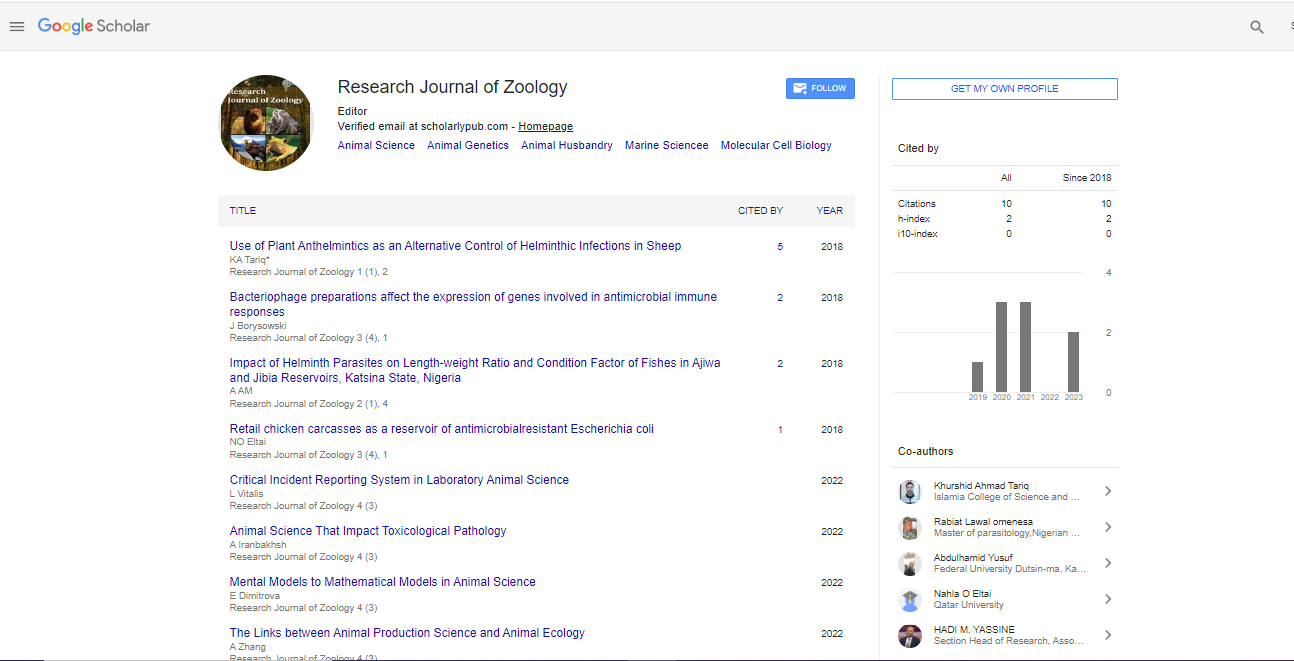Commentary, Res J Zool Vol: 5 Issue: 2
Echinoderm: Exploring the Enigmatic Nature of Marine Invertebrates
Elodie Lambrechts*
1Department of Marine Biology, University of Copenhagen, Copenhagen, Denmark
*Corresponding Author: Elodie Lambrechts,
Department of Marine Biology, University
of Copenhagen, Copenhagen, Denmark
E-mail: lambrechtselodie@gmail.com
Received date: 29 May, 2023, Manuscript No. RJZ-23-107019;
Editor assigned date: 31 May, 2023, PreQC No. RJZ-23-107019 (PQ);
Reviewed date: 14 June, 2023, QC No. RJZ-23-107019;
Revised date: 21 June, 2023, Manuscript No. RJZ-23-107019 (R);
Published date: 28 June, 2023, DOI: 10.4172/Rjz.1000086.
Citation: Lambrechts E (2023) Echinoderm: Exploring the Enigmatic Nature of Marine Invertebrates. Res J Zool 5:2.
Description
Echinoderm is the study of diverse and fascinating group of marine invertebrates. Echinoderms belong to the phylum Echinodermata, which includes familiar creatures such as sea stars (starfish), sea urchins, sea cucumbers, brittle stars, and crinoids. These unique animals are known for their spiny skin, radial symmetry, and a water vascular system that allows them to move and feed. Echinoderms play a vital role in marine ecosystems and have captivated scientists and marine enthusiasts alike with their remarkable biology and behavior.
Radial symmetry: Echinoderms typically exhibit radial symmetry, which means their bodies are organized around a central axis, often in multiples of five. This symmetry allows them to access their environment from all sides equally.
Water vascular system: One of the defining features of echinoderms is their water vascular system. This hydraulic system consists of a series of fluid-filled canals and tube feet that aid in locomotion, gas exchange, and feeding. Most echinoderms have five arms, giving them a pentaradial body plan. However, some species may exhibit variations, such as sea stars with multiple arms or sea cucumbers with elongated bodies.
Endoskeleton: Echinoderms possess a unique endoskeleton made of calcareous plates or ossicles. These plates give them their characteristic spiny appearance and provide structural support for their bodies.
Asteroidea (Sea stars): Sea stars are perhaps the most iconic echinoderms, with their five or more arms radiating from a central disc. They are predators, using their tube feet to grasp and pull apart the shells of bivalves and other prey.
Echinoidea (Sea urchins and sand dollars): Sea urchins are spherical or flattened echinoderms covered in long spines. They graze on algae and other organic material using their specialized mouthparts, called Aristotle's lantern. Sand dollars are flattened, disk-shaped relatives of sea urchins.
Holothuroidea (Sea cucumbers): Sea cucumbers have elongated, cucumber-like bodies and a reduced endoskeleton. They play an essential ecological role in recycling organic matter in marine environments.
Ophiuroidea (Brittle stars): Brittle stars have long, flexible arms that they use for movement, capturing food particles, and for defense. They are typically faster and more agile than sea stars.
Crinoidea (Sea lilies and feather stars): Crinoids are ancient echinoderms with feathery arms that capture plankton from the water. Some species are attached to the seabed (sea lilies), while others can swim (feather stars).
Echinoderms inhabit a wide range of marine environments, from shallow intertidal zones to the deepest ocean trenches. They can be found from Polar Regions to tropical seas, showcasing their adaptability and resilience. Echinoderms play various roles in marine ecosystems. For example, sea stars help control populations of bivalves, while sea urchins can have a significant impact on kelp forests by grazing on algae. Sea cucumbers are important detritivores, consuming organic matter and contributing to nutrient cycling.
Reproduction and regeneration
Echinoderms exhibit diverse reproductive strategies. Most echinoderms have separate sexes, but some species are hermaphroditic. Fertilization often occurs externally, and some echinoderms have complex larval stages before reaching adulthood.
One of the most remarkable features of echinoderms is their ability to regenerate lost body parts. Many species can regrow arms, tube feet, or even whole body sections if damaged or injured. This regeneration is facilitated by a unique system of specialized cells and tissues. Echinoderm zoology plays an important role in understanding marine biodiversity, evolutionary history, and ecological interactions. Echinoderms have also become essential models for developmental biology and regenerative studies due to their impressive regenerative capabilities. Moreover, monitoring and studying echinoderm populations are vital for assessing the health of marine ecosystems and guiding conservation efforts.
Conclusion
Echinoderms are captivating marine invertebrates that have fascinated scientists and nature enthusiasts for centuries. Echinoderm zoology offers a window into the evolutionary wonders of these spinyskinned creatures and their vital ecological roles in marine ecosystems. By delving into the world of echinoderms, researchers gain valuable insights into the complexities of life in the ocean and the interconnectedness of all living organisms within our planet's intricate web of life.
 Spanish
Spanish  Chinese
Chinese  Russian
Russian  German
German  French
French  Japanese
Japanese  Portuguese
Portuguese  Hindi
Hindi 
